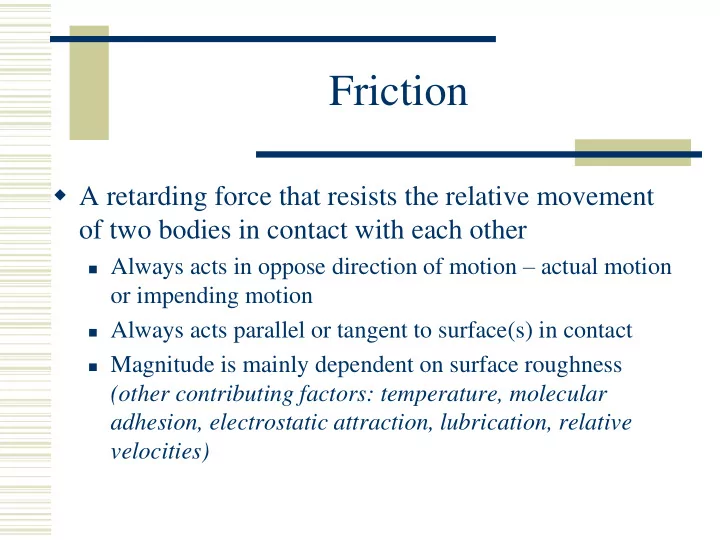

Friction A retarding force that resists the relative movement of two bodies in contact with each other Always acts in oppose direction of motion – actual motion or impending motion Always acts parallel or tangent to surface(s) in contact Magnitude is mainly dependent on surface roughness (other contributing factors: temperature, molecular adhesion, electrostatic attraction, lubrication, relative velocities)
Coefficient of Static Friction on Dry Surfaces Coefficient of Static Friction or μ Materials 0.15 – 0.60 Metal on metal 0.20 – 0.60 Metal on wood 0.30 – 0.70 Metal on stone 0.30 – 0.60 Metal on leather 0.25 – 0.50 Wood on wood 0.25 – 0.50 Wood on leather 0.40 – 0.70 Stone on stone 0.20 – 1.00 Earth on earth 0.60 – 0.90 Rubber on concrete
Friction Two types of friction Dry or Coulomb friction Static – surfaces are at rest with respect to each other Kinetic/dynamic – surfaces are moving with respect to each other Fluid Friction Viscosity, friction developed between layers of a fluid moving at different velocities We’ll limit our discussion to dry friction
Friction Theory Consider a block on a horizontal surface No Frictional resistance N is referred to as the Normal force, perpendicular to the contact surface W N
Friction Theory Next an external force is applied If no friction, block would immediately move If force is applied, F = P, for equilibrium At some point, P > F, motion occurs W P F N
Friction Theory Ratio of F to N is called the Coefficient of Static Friction or μ F s N Where μ s = coefficient of static friction (unitless) F – Max or limiting frictional force resistance (lb, k, N) N – Normal force, perpendicular to contact surface (lb, k, N)
Friction Theory Stated another way: F s = μ s N (for impending motion) F k = μ k N (for sustaining motion, kinetic ) In general: F ≤ μ N
Recommend
More recommend